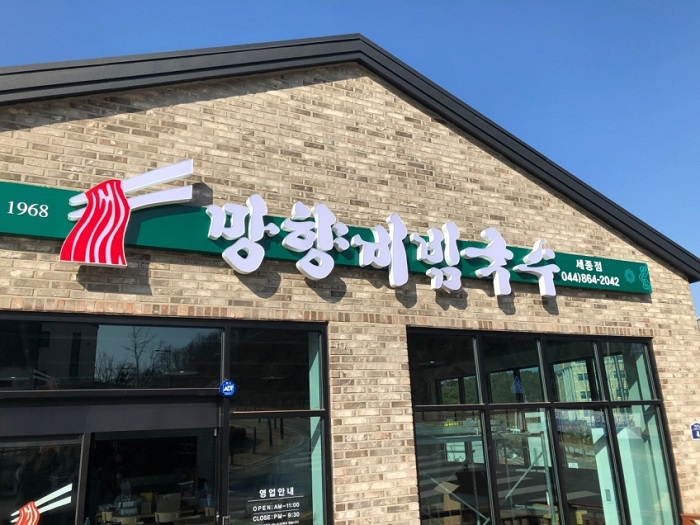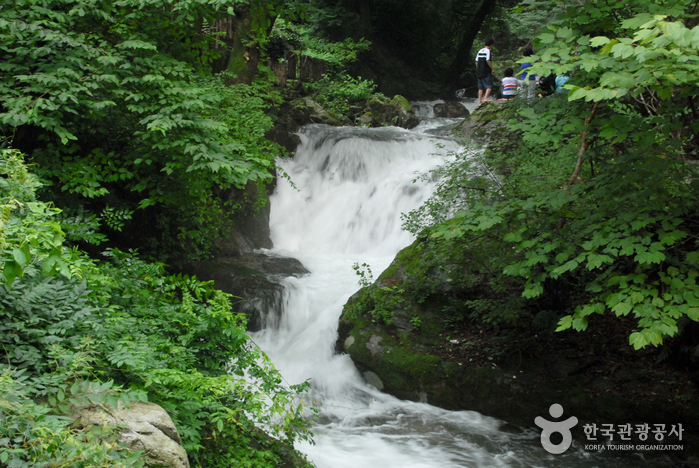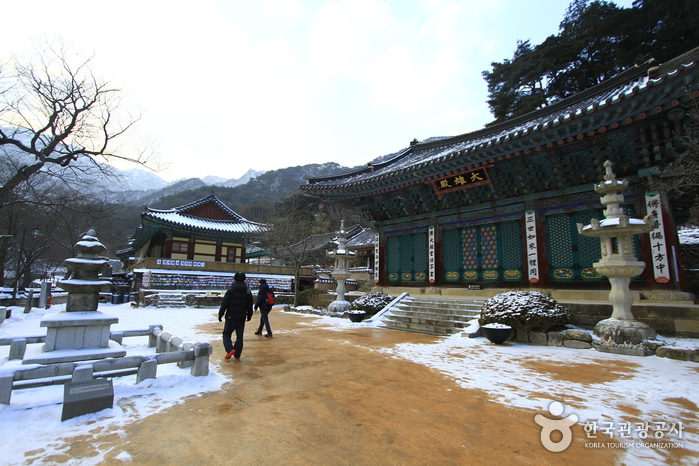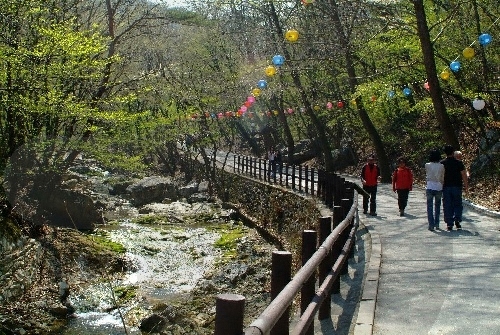Manghyang Bibimguksu Sejong Branch (망향비빔국수 세종)
9.9 Km 124 2024-03-20
4 Bareun 7-gil, Sejong-si
+82-44-864-2042
Manghyang Bibimguksu is a Korean noodle specialty restaurant located in Sejong Administrative City. Its signature dish is bibim guksu (spicy noodles), which is spicy noodles mixed with a special sauce. Additionally, they offer other dishes such as janchi guksu (banquet noodles), mandu, kimchi mandutguk (kimchi mandu soup), and dongaseu (pork cutlet). Nearby, there's the Ogarnangtteul Neighborhood Park, providing a pleasant setting for a meal and a stroll.
Sejong National Arboretum (국립세종수목원)
10.4 Km 0 2023-01-25
136, Sumogwon-ro, Sejong-si
+82-44-251-0001
The Sejong National Arboretum, which is about to open as the first urban arboretum in Korea, was built on an area of 65 ha adjacent to the Sejong Government Complex, where several government ministries are located. It is possible to see 2,834 species of 1.72 million plants (including 45,958 trees) under various themes such as the nation's largest four-season greenhouse, traditional Korean garden, Cheongryujiwon for study, and bonsai garden. It is another national arboretum established following the Baekdudaegan National Arboretum following the National Arboretum Expansion Plan for conserving and developing genetic tree resources by climate and vegetation zone.
Sabiseong (Donghak Sanjang Hotel Korean restaurant) (사비성 (동학산장호텔 한식당))
10.8 Km 20280 2024-02-21
266-4 Donghaksa 1-ro, Banpo-myeon, Gongju-si, Chungcheongnam-do
042-825-4301
Sabiseong is a Korean restaurant operated by Donghak Sanjang Hotel, located on the eastern slope of Gyeryongsan Mountain. It offers a variety of traditional Korean dishes such as sagor ugeojiguk (kimchi cabbage soup), hwangtae kongnamulguk (dried pollack and bean sprout soup), yukgaejang (spicy beef soup), sanchae bibimbap (wild vegetable bibimbap), and grilled dishes like samgyeopsal (pork belly) and ori hunje (smoked duck). Nearby attractions include Gyeryongsan National Park, Donghaksa Temple, and the Korean Natural History Museum.
Gyeryongsan National Park (계룡산국립공원)
10.9 Km 48858 2021-09-06
327-6, Donghaksa 1-ro, Gongju-si, Chungcheongnam-do
+82-42-825-3002
Gyeryongsan National Park stretches across the cities of Daejeon, Gongju, and Nonsan in Chungcheongnam-do and was made a national park on December 31, 1968. The name of the mountain comes from the fact that the ridgeline looks like a dragon wearing a chicken's crest on its head. The topographical features are what make this mountain stand out and its mysterious folklore is what makes it so interesting. The park features many peaks, including the main peak Cheonhwangbong (alt. 845.1 m), as well as Sambulbong, Yeoncheonbong, and Gwaneumbong Peaks. This mountain is famous for its many interesting sites, with its fantastic rock structures and Yongmunpokpo Falls on the west, Eunseonpokpo Falls to the east, and Amyongchu and Sutyongchupokpo Falls in the south.
In spring, cherry blossoms bloom along the path to Donghaksa Temple, and during summer the lush green of the valley is very beautiful. During fall, the maple trees reveal their crimson colored leaves around Gapsa Temple and Yongmunpokpo Falls. The snowcapped peak of Sambulbong in winter is simply breathtaking. Gyeryongsan is full of rare animals and plants, beautiful waterfalls and a rich history with mysterious legends and cultural treasures. To the east is Donghaksa Temple; northwest, Gapsa Temple; southwest, Sinwonsa Temple; and southeast, Yonghwasa Temple.
Gongju Donghaksa Temple (동학사(공주))
10.9 Km 33524 2020-03-16
462, Donghaksa 1-ro, Gongju-si, Chungcheongnam-do
+82-42-825-2570
Located in the east valley of Gyeryongsan Mountain in Hakbong-ri, Banpo-myeon, Gongju, Donghaksa Temple is the first and the oldest existing academic institute for female monks. Home to about 150 monks who study and practice Buddhism, the temple is the most visited spot on all of Gyerongsan Mountain due to its history, convenient location, and visitor facilities.
The elegant structure of the temple is x_heighted by the majestic view of Munpilbong Peak to its front. In the spring, many visitors come to the temple to see the cherry blossom tunnel, a 3 kilometer pathway from Bakjeongja three-way intersection to Donghaksa Temple. Every year since 1993 the temple has also been the venue of the Donghaksa Spring Flower Festival.
Donghaksagyegok Valley (동학사계곡)
10.9 Km 35878 2024-02-28
327-6 Donghaksa 1-ro, Banpo-myeon, Gongju-si, Chungcheongnam-do
Donghaksagyegok Valley is a 3.5km-long valley located near Donghaksa Temple within Gyeryongsan National Park in Gongju-si. It is surrounded by lush green forests where wildflowers bloom, and the sound of clear water and birds can always be heard. The valley features attractions such as Donghaksa Temple, Eunseonpokpo Falls, and wild birds. While beautiful in all seasons, it is most stunning during spring when everything is in vibrant green.
BOK Art Center (비오케이아트센터)
11.4 Km 0 2023-01-25
12, Gukchaegyeonguwon 3-ro, Sejong-si
+82-1877-4955
BOK Art Center is located in Bangok-dong, Sejong-si. It was opened in 2019 with the management philosophy of CEO I Gyu-sun, 'Let's create a happier living space.' The center is equipped with a performance hall where various performances are held, a gallery where various exhibitions are held, a hobby factory specialized for kidults, a Ccume Baking Class where you can enjoy baking, a bookstore, and a cafe.
Haklimjae [Korea Quality] / 학림재 [한국관광 품질인증/Korea Quality]
11.4 Km 3 2021-03-29
75-3, Taesan-gil, Sejong-si
This hanok (traditional Korean house) accommodation is located in Taesan-ri, Janggun-myeon, Sejong Special Self-governing City. Its doors open to an expansive and handsome grass courtyard, with stone fences, a pond, a pavilion, stone figures, pine trees, and a furnace with a cast-iron pot.
The entire house with a courtyard is rented out in whole, with three rooms, a kitchen, a living room, and two bathrooms. There are a beam projector and a karaoke machine in the house, which makes it popular for family gatherings, corporate training sessions, or club meetings. The house has also been used for traditional marriage ceremonies and outdoor exhibitions. An outdoor barbecue area allows the guests to do some outdoor grilling, but guests can also opt to use the furnace and the traditional cast-iron pot for grilling as well. Seasonal vegetables and fruits grown in the garden are offered to guests free of charge as well. The management also offers traditional sauce-making, wood carving, tea ceremony, and meditation upon reservation.
Banseok Hanuchon (반석 한우촌)
12.6 Km 2797 2024-02-13
56 Banseok-ro 12beonan-gil, Yuseong-gu, Daejeon
Banseok Hanuchon is a restaurant specializing in hanu (Korean beef), renowned for its tender texture. The menu boasts a variety of cuts, including sirloin, chuck flap tail, thin skirt, and inside skirt. At an affordable price, customers can enjoy a hearty meal with a variety of fresh vegetables for wraps and diverse side dishes. Additionally, fresh yuk sashimi (sliced raw beef) and yukhoe (beef tartare) are available, and their galbitang (galbi soup) and bulgogi jeongol (bulgogi hot pot) stand out as popular choices.
Gyeryongsan Mountain Sanshinje Festival (계룡산 산신제)
12.7 Km 3273 2020-07-29
Gyeryong-myeon, Gongju-si, Chungcheongnam-do
• 1330 Travel Hotline: +82-2-1330 (Korean, English, Japanese, Chinese) • For more info: +82-10-5807-4344
Gyeryongsan Mountain Sanshinje Festival is an annual traditional ceremony to worship and celebrate the mountain spirits. The ceremony draws many visitors thanks to the beautiful spring scenery of Gyeryongsan Mountain. There are also many attractions and traditional performances during the event. Yanghwa-ri Village, the main venue of the festival, is where the heritage and culture of Sanshinje ceremony are well preserved.





![Haklimjae [Korea Quality] / 학림재 [한국관광 품질인증/Korea Quality]](http://tong.visitkorea.or.kr/cms/resource/56/2707656_image2_1.jpg)
 English
English
 한국어
한국어 日本語
日本語 中文(简体)
中文(简体) Deutsch
Deutsch Français
Français Español
Español Русский
Русский